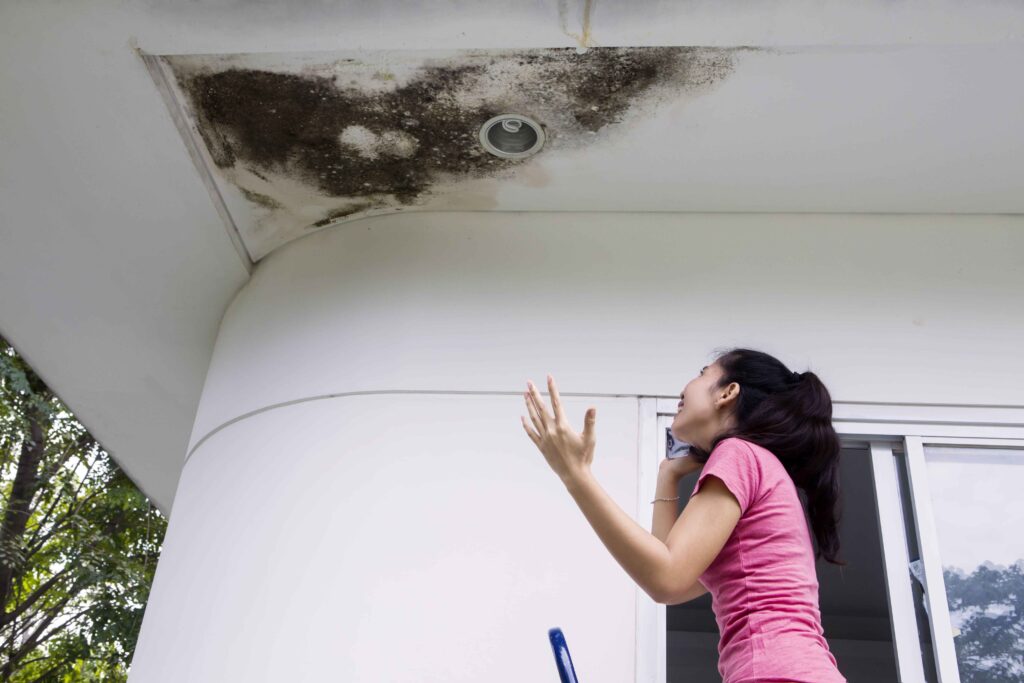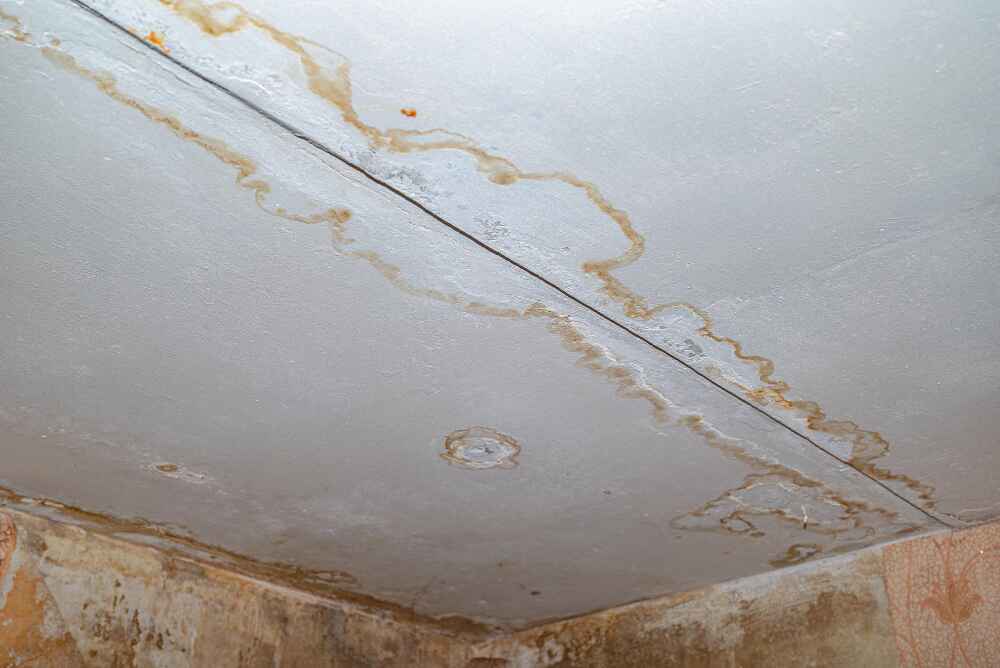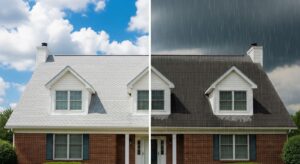Imagine this: you’re lounging on your couch during a quiet evening when you hear it — drip. Another drip. You look up, and there’s a faint stain blooming on the ceiling. Yep. You’ve got a roof leaking in one spot — and while it might seem minor, it could signal a bigger problem.
What gives?
Whether it’s a mysterious ceiling stain or water dripping from the roof outside, a one-spot leak may seem like no big deal. But it’s often the red flag for something more serious — hidden damage that could compromise your roof’s integrity.
In this guide, we’ll break down:
- Why You Might Have a Roof Leaking in One Spot
- Common causes and hidden culprits
- What to do ASAP (hint: don’t grab the duct tape)
- How to fix it right the first time
- Tips to prevent repeat leaks
Let’s get your roof back to doing what it does best — keeping the weather out and your peace of mind in.
Why Is My Roof Leaking Water in Just One Spot?
A roof leak that’s isolated to one location can be deceiving. It might look like a minor nuisance, but leaks don’t always follow a straight path — water travels.
Common Causes of a Localized Roof Leak:
- Cracked flashing – That thin metal around chimneys, vents, and valleys can corrode or shift over time. Use this roof flashing maintenance guide to stay ahead.
- Compromised roof underlayment – A weak layer beneath shingles can allow water to seep through.
- Vent boot failure – Those rubber seals around plumbing vents can dry out and crack.
- Ice dams – In colder climates, these can trap melting snow under your shingles.
- Gutter backups – Water overflows and sneaks under the edge of your roof.
Internal vs. External Signs:
- Inside: Water stains, peeling paint, mildew smells, sagging drywall
- Outside: Buckled flashing, loose seals around penetrations, missing granules near leak origin
Pro Tip: A “one-spot” leak is often just the visible part. The actual water entry point could be several feet away.
For a full breakdown of common roof issues, check out Most Common Roof Repairs.
Water Dripping From Roof Outside? Do This First
When you spot water dripping from your roof’s edge — even when it’s not raining — it can indicate a bigger issue like trapped moisture or clogged drainage.
Immediate Steps to Take:
- Turn off electricity if the leak is near light fixtures.
- Contain the leak with buckets or towels to minimize damage.
- Document the damage (photos/videos) for potential insurance claims.
- Don’t climb the roof — especially when it’s wet or stormy.
Quick DIY Checks You Can Do Safely:
- Inspect the attic for wet insulation or water trails.
- Look for signs of condensation, especially around vents.
- Use binoculars to scan for lifted shingles or cracked flashing.
Roof Leaking But Shingles Look Good? Here’s What’s Really Going On
This one throws a lot of homeowners off. You head outside, inspect the roof, and everything looks intact. So why the leak?
Here’s What Could Be Hiding Beneath the Surface:
- Flashing failure beneath shingles — especially at valleys and around chimneys.
- Improperly sealed roof penetrations — like skylights, vents, or solar panel mounts.
- Ventilation issues — Poor ventilation can cause condensation leaks. Here are trusted attic moisture prevention tips from the U.S. Department of Energy.
- Nail pops — fasteners backing out over time create entry points.
Reminder: Water doesn’t always enter at the leak point. It can travel along rafters or beams and show up far from the source.
Learn more about misleading damage signs in Wind Damage Roof Shingles.
Diagnosing a Roof Leak Like a Pro
Fixing a leak without knowing its exact source is like playing whack-a-mole with your wallet. Here’s how the pros get it right:
Tools Roofers Use:
- Moisture meters – detect damp spots even behind insulation.
- Infrared cameras – show cold/wet areas invisible to the eye.
- Controlled hose tests – isolate the source by mimicking rainfall.
When to DIY vs. Hire Help:
Scenario | DIY-Friendly? |
Replacing the vent boot | Maybe, if you’re handy and it’s dry |
Flashing leak around the chimney | Call a pro — risk of structural damage |
Replacing shingles | Only if minor and you’re comfortable on a roof |
A leak is recurring in the same spot | Definitely call a roofer |
How to Fix a Roof Leak in One Spot on Your Home

So you’ve found the leak (or at least narrowed it down). Here’s what your options look like:
Short-Term Fixes:
- Roofing tape or flashing sealant to patch small cracks
- Tarping the roof securely until a contractor can assess
- Gutter cleaning if overflow was the cause
Long-Term Repairs:
- Replace deteriorated flashing or underlayment
- Reseal or replace vent boots and pipe collars
- Patch or replace shingles in the affected area
Pro Tip: Even if it’s “just one spot,” improper repairs can void your roof warranty or insurance coverage. Always use certified materials and methods.
Learn how to file a claim for storm-related roof leaks at Roof Damage Insurance Claim Process.
How to Prevent Future One-Spot Leaks
The best leak is the one that never happens. Here’s how to protect your roof moving forward.
Maintenance Checklist:
- Inspect flashing and vent boots every 6 months
- Clean gutters and downspouts seasonally
- Check attic for moisture/mold signs quarterly
- Seal around chimneys and skylights annually
Upgrade Weak Spots:
- Use high-performance flashing (e.g., metal not rubber)
- Add ice/water shield underlayment in snowy regions
- Improve attic ventilation to reduce condensation
FAQs About Roof Leaking in One Spot
Can a roof leak in one spot but still be structurally sound?
Yes — but it’s still a sign of vulnerability. Ignoring it could lead to mold, wood rot, or insulation damage.
How do I find the exact source of a leak?
Follow water stains in the attic, or use a moisture meter. Still unsure? A roofing contractor will pinpoint it using thermal imaging or controlled testing.
Should I replace the whole roof over one leak?
Not usually. If your roof is under 15 years old and the damage is localized, targeted repair is often enough — unless there’s a systemic issue like poor installation.
How much does it cost to fix a one-spot leak?
On average, expect to pay between $150–$600 for minor repairs, or more if structural components (like decking) are affected.
Final Thoughts: Don’t Ignore That One Drip
A roof leak in one spot may seem small, but it’s often the tip of a very soggy iceberg. Whether it’s a slipped flashing, a hidden puncture, or blocked gutters wreaking havoc, ignoring the signs can lead to far bigger (and costlier) problems.
Here’s your next step:
Get it inspected now — before minor becomes massive. Protect your home, preserve your investment, and sleep easy knowing the only thing dripping is your fresh-brewed coffee.
Book a professional roof inspection today. Don’t wait until it’s raining in your living room.






